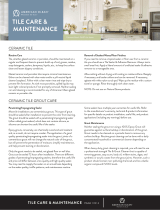Page is loading ...

Use, Clean, & Care Manual
Marble care
Marble is a calcium-rich stone, porous and susceptible to expansion. When spills are
left on a marble countertop, they seep into the pores. Over time, this leads to cracks.
It's important to wipe up any spills immediately, then wipe the area with a little water
and dry immediately.
Never allow wet dishes, glasses or water to stand on a marble countertop for any
length of time. Water will seep into the stone and leave a permanent ring to remind
you where the water was. This is caused by a permanent change in the marble's
composition and can only be removed by professional polishing. You'll need to select a
cleaning solution that is made specifically for cleaning marble. Most regular household
cleaners contain acid, which can damage the finish. Cleaners with citric acid must be
avoided. Neutral cleaners, such as phosphate-free solutions or dishwashing liquids,
will work in a pinch. The trick to using any cleaning agent on your countertop is to
rinse the soap off immediately with warm water to avoid drying out the marble.
Q: Do the sink chests need to be professionally installed?
A: No. However, we highly recommend it for not only the chest but also the basin and
fixtures.
Q: Is it possible to change the finishes or tops on Bellaterra Home Collections?
A: No. All products in our lines are available only as shown.
Q: Care & Maintenance
A: stone - *Clean stone surfaces with a neutral cleaner, stone soap, or a mild liquid
dishwashing detergent and warm water.
*Use a clean rag mop on floors and a soft cloth for other surfaces for best results.
*Rinse the surface thoroughly after washing with the soap solution and dry with a soft
cloth.
*Change the rinse water frequently.
*In the bath or other wet areas, soap scum can be minimized by using a squeegee
after each use. To remove soap scum, use a non-acidic soap scum remover or a
solution of ammonia and water (about 1/2 cup ammonia to a gallon of water).
Frequent or over-use of an ammonia solution may eventually dull the surface of some
stone types.
There are natural stone cleansers available on the market that is made specifically for
use on floors, hearths or countertops that can be found in a local hardware store.
Many flooring companies offer steam services for natural stone areas as well. In any
case, when completing the cleansing at home, it is always best to sweep the area free
of dirt and debris before beginning. Any leftover debris can scratch the area when

cleaning or drying. Home cleansers can leave a residue on natural stone, and should
always be rinsed well and dried to keep from having water spots.
glass - Though there are countless products on the market claiming to wipe streaks
away, we recommend the most basic of options: kitchen-sink soap. The best way to
clean your glasses is to run them under warm water and put a tiny drop of
dishwashing detergent on the tip of your fingers to create a lather on the lens. Then
rinse with warm water, and dry with a clean, soft cotton cloth.
ceramic - *Sweep or vacuum surface to remove loose dirt.
*Mix water with tile and grout cleaner and apply it to surface.
*Allow solution to sit for 3-5 minutes. Agitate with sponge or mop.
*Rinse mop and change cleaning solution at least every 500 square feet. Rinse
thoroughly with clean water.
*Dry mop floor to remove moisture or pick up residue with a wet-vac and then wipe
the floor dry.
Tips: Improper care of ceramic surface can result in a residue build-up on the surface,
causing it to be hazardous. Wax oil-based detergent may decrease the slip resistance
and are not recommended for ceramic surface.
wood - Don't avoid dusting furniture. Frequent dusting removes airborne deposits
that build up in a filmy layer and can scratch the surface. Clean, dry, soft cloths or
feather dusters will effectively remove dust; however, to avoid scattering the dust into
the air, where it floats until landing back on furniture surfaces, dampen the cloth very
slightly. Never use all-purpose cleaning sprays unless your furniture has a plastic
coating, such as the kind used on kitchen tables and children's furniture. You'll usually
want to avoid cleaning wood with water. However, sticky spots may need to be
treated with soap and water. Here's how: dip the cloth in mild soap or detergent
dissolved in water, wring the cloth nearly dry, and wipe the area. Rinse and
immediately dry with a clean, soft cloth.
/




